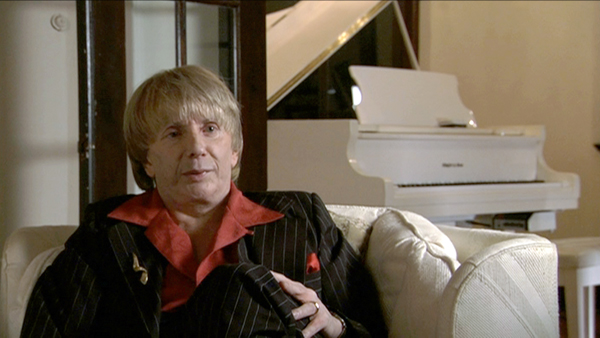|
Reviews of Recent Independent, Foreign, & Documentary Films in Theaters and DVD/Home Video

THE AGONY AND THE ECSTASY OF PHIL SPECTOR The Agony and the Ecstasy of Phil Spector is a fascinating psychobiography of an enigmatic rock ‘n’ roll legend-turned-tabloid sensation. Some may know Spector mostly for the lurid shooting death of actress Lana Clarkson in his Southern California mansion in 2003 and the subsequent televised trials that dragged on through 2009, when he was in his 60s. Trial footage and news coverage, with all its gruesome CSI detail and conflicting views on the victim, consume half this documentary. But the rest of the film remembers another side of Phil Spector. The first 45 single my older sister bought, in 1958, was the Teddy Bears’ “To Know Him Is to Love Him,” the first song written by Spector. (He’s seen performing it as part of that group.) The first record I bought, in 1962, was the Spector-produced “He’s A Rebel” by the Crystals, and over the next decade I continued to eagerly buy the “little symphonies for the kids,” as he described them, which he wrote and produced for the Ronettes, the Righteous Brothers, and others as his music withstood the British Invasion. He was known as an eccentric perfectionist then, and fans appreciated that he was among the first to take rock ‘n’ roll seriously as a popular art form. Director Vikram Jayanti takes him seriously, too, in Spector’s first extensive film interview, with his music, somewhat chronologically, illustrating recurring themes of loneliness, paranoia, despair, and a yearning for acceptance. Jayanti gets Spector to talk about his early years, drawing him out about the impact of his father’s suicide when he was nine, and his feelings of being an outsider in high school when the family moved from New York to California. Women frequently link the parts of his life. The film opens with the Crystals singing his song “He Hit Me (and It Felt Like a Kiss)” that he shockingly included on his 1991 “Back to Mono” box set, the song’s first release since being quickly withdrawn in 1962. The trial clips detail Spector’s troubled relationships with a parade of women (and guns). However, Jayanti does not delve into the irony of Spector’s making girl groups transcendent (artists the Rock ‘n’ Roll Hall of Fame disdained for years as tools for producers). Spector relishes his later work with Tina Turner, but dismisses Darlene Love, whose powerfully soulful voice he used ubiquitously and often anonymously in many 1960’s groups. He still owes royalties to her. (There is no mention of his notorious marriage to the Ronettes’ lead singer, Ronnie.) In this BBC production, Jayanti perks up when asking about Spector’s musical career in Britain that coincided with the dissolution of the Beatles and their splintering into separate careers. (Jayanti is thrilled to be in the same room with the white grand piano on which John Lennon composed “Imagine.”) Spector produced albums with Lennon and George Harrison, and is defensive that these records got short shrift during the break-up brouhaha. He especially praises Lennon’s “Woman Is the Nigger of the World” song from 1972. It’s very frustrating how uninformed Jayanti is about Spector’s American music. To make up for Jayanti’s lack of expertise, insightful analysis of each song by journalist Mick Brown, author of Tearing Down The Wall Of Sound: The Rise and Fall of Phil Spector, scrolls along the bottom of the screen during the performance clips from an unidentified Hullabaloo/Shindig type of show, which include what must be the only time the Ronettes did not dress as “The Bad Girls of Rock ‘n’ Roll” in sexy dresses with high slits up their legs. Only a Righteous Brothers’ performance of “You’ve Lost That Lovin’ Feelin’” is seen and heard uninterrupted in all its poignant glory. Jayanti asks very little about how Spector created his spectacularly layered trademark “Wall of Sound,” and there’s nothing about working with the Wrecking Crew, his legendary sessions band that included Glen Campbell, Dr. John, Leon Russell, and Hall of Fame drummer Hal Blaine. Over
their three-and-a-half-hours together, Jayanti’s ignorance usefully
triggers Spector’s pique to reveal his
bitterness and persistent grudges, though occasionally his annoyance is
justified exasperation at his interlocutor. Spector lets loose barbs
against the Beach Boys’ Brian Wilson, Martin Scorsese’s unauthorized use
of “Be My Baby” in Mean Streets, Tony Bennett’s revived career,
and Buddy Holly’s legacy.
Interviewed in the midst of his trials, Spector rants about his negative
experiences with the legal system and defends his wild hair styles that
did so much to influence the perception of him as crazy. (Spector’s
only previous interview was a brief,
bizarre appearance in the PBS/BBC 1995 documentary series Rock ‘n’
Roll, which added to his reputation as a weird recluse.)
While he was found sane enough to go to jail, his music echoes through
this film as a lasting legacy to the beauty and harmony that he could
not find elsewhere in his life. Nora Lee
Mandel
|

